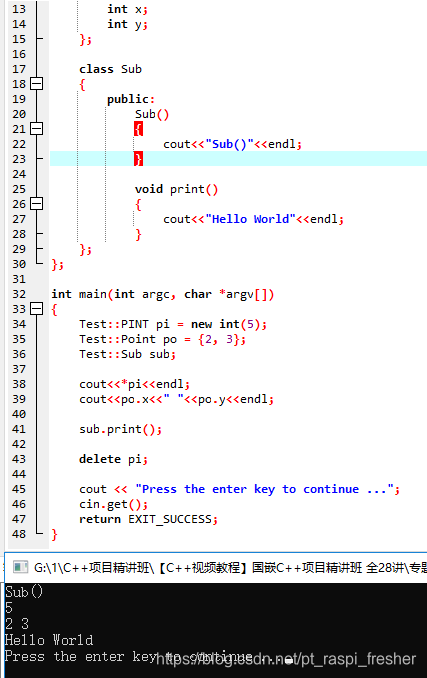版权声明:本文为博主原创文章,未经博主允许不得转载。 https://blog.csdn.net/pt_raspi_fresher/article/details/88626972
-------------------------------------资源来源于网络,仅供自学使用,如有侵权,联系我必删.
第一:
历史的痕迹
你可能会看到类似下面的模板定义

#include <cstdlib>
#include <iostream>
using namespace std;
template<class T> //template<typename T>
T Minus(T a, T b)
{
return a - b;
}
template<class T>
class Add
{
public:
T add(T a, T b)
{
return a + b;
}
};
int main(int argc, char *argv[])
{
//类模板 减法
cout<<Minus(3, 4)<<endl;
cout<<Minus<float>(0.3, 0.4)<<endl;
//类模板 加法
Add<double> ap;
cout<<ap.add(9, 8)<<endl;
cout<<ap.add(0.001, 0.1)<<endl;
cout << "Press the enter key to continue ...";
cin.get();
return EXIT_SUCCESS;
}
为什么 class 可以用来定义模板参数呢?
为什么还要引进 typename呢?
第二:
在类中可以定义其它的新类型

#include <cstdlib>
#include <iostream>
using namespace std;
class Test
{
public:
typedef int* PINT;//定义指针类型
struct Point//定义结构体类型
{
int x;
int y;
};
class Sub//定义内部类的类型
{
public:
Sub()
{
cout<<"Sub()"<<endl;
}
void print()
{
cout<<"Hello World"<<endl;
}
};
};
int main(int argc, char *argv[])
{
Test::PINT pi = new int(5);//指针pi 指向堆空间 初始化
Test::Point po = {2, 3};//结构体po 初始化
Test::Sub sub;//调用构造函数Sub()
cout<<*pi<<endl;//打印pi指向空间的值
cout<<po.x<<" "<<po.y<<endl;
sub.print();
delete pi;//释放
cout << "Press the enter key to continue ...";
cin.get();
return EXIT_SUCCESS;
}
第三:
在类模板中定义新的类型

在函数模板中使用类模板的内部类型

#include <cstdlib>
#include <iostream>
using namespace std;
template<typename T, int N>
class Test
{
public:
typedef T ElemType;//将T定义为一个新名字ElemType
enum { LEN = N };//定义枚举类型
ElemType array[LEN];//定义数组
};
template<typename T> //template<class T> 报错!!! 需要用typename 关键字!!!
void test_copy(T& test, typename T::ElemType a[], int len)//for循环复制
{
int l = (len < T::LEN) ? len : T::LEN;//取较小值
for(int i=0; i<l; i++)
{
test.array[i] = a[i];
}
}
int main(int argc, char *argv[])
{
Test<int, 5> t1;//类模板内部定义新类型
Test<float, 3> t2;
int ai[] = {5, 4, 3, 2, 1, 0};//赋初始值
float af[] = {0.1, 0.2, 0.3};
test_copy(t1, ai, 6);
test_copy(t2, af, 3);
for(int i=0; i<5; i++)
{
cout<<t1.array[i]<<endl;
}
for(int i=0; i<Test<float, 3>::LEN; i++)
{
cout<<t2.array[i]<<endl;
}
cout << "Press the enter key to continue ...";
cin.get();
return EXIT_SUCCESS;
}
为什么 class 可以用来定义模板参数呢?
为什么还要引进 typename 呢?
模板最初的目标只是为了对类类型进行泛型操作的定义,因此用 class 关键字声明泛型类型
在之后的进化过程中发现了模板相互调用时产生的 :: 操作符的二义性
因此引入 typename 关键字是用于告诉编译器将 ::符号后的标识符看作类型
第四:
拾遗
C++ 中仍然支持C 语言中的可变参数函数
C++ 编译器的匹配调用优先级
第一级: 重载函数
第二级: 函数模板
第三级: 可变参数函数
C++编译器匹配示例

#include <cstdlib>
#include <iostream>
using namespace std;
int test(int i, int j)
{
cout<<"int test(int i, int j)"<<endl;
}
template<typename T>
T test(T i, T j)
{
cout<<"T test(T i, T j)"<<endl;
}
int test(...)//可变参数函数
{
cout<<"int test(...)"<<endl;
}
int main(int argc, char *argv[])
{
int i = 0;
int j = 0;
test(i, j);//重载函数优先选择 int test(int i, int j)
cout << "Press the enter key to continue ...";
cin.get();
return EXIT_SUCCESS;
}
第五:
函数模板与可变参数函数的化学反应

//写函数判断一个变量是否为指针吗?
#include <cstdlib>
#include <iostream>
using namespace std;
template<typename T>
void isPtr(T*)//指针参数
{
cout<<"void isPtr(T*)"<<endl;
}
void isPtr(...)//可变参数
{
cout<<"void isPtr(...)"<<endl;
}
int main(int argc, char *argv[])
{
int* pi = NULL;
float* pf = NULL;
int i = 0;
int j = 0;
isPtr(pi);//指针
isPtr(pf);//指针
isPtr(i);//非指针
isPtr(j);//非指针
cout << "Press the enter key to continue ...";
cin.get();
return EXIT_SUCCESS;
}
解决方案1

//写函数判断一个变量是否为指针吗?
#include <cstdlib>
#include <iostream>
using namespace std;
template<typename T>
bool isPtr(T*)
{
return true;
}
bool isPtr(...)
{
return false;
}
int main(int argc, char *argv[])
{
int* pi = NULL;
float* pf = NULL;
int i = 0;
int j = 0;
cout<<isPtr(pi)<<endl;
cout<<isPtr(pf)<<endl;
cout<<isPtr(i)<<endl;
cout<<isPtr(j)<<endl;
cout << "Press the enter key to continue ...";
cin.get();
return EXIT_SUCCESS;
}
你的方法实现了指针的判断,但是我觉得不够高效,你有更好的办法吗?
分析:
解决方案1 已经很好的解决面试官的问题,那么为什么还不够高效呢?哪里不够高效呢?
解决方案1 中的唯一耗时的地方在于函数调用的建栈与退栈过程,因此需要考虑如何避免这个过程以提高程序效率。
解决方案2

//写函数判断一个变量是否为指针吗?
#include <cstdlib>
#include <iostream>
using namespace std;
template<typename T>
char isPtr(T*);
int isPtr(...);
#define ISPTR(v) (sizeof(isPtr(v)) == sizeof(char)) //宏定义,避免函数调用,使用sizeof避免开销
int main(int argc, char *argv[])
{
int* pi = NULL;
float* pf = NULL;
int i = 0;
int j = 0;
cout<<ISPTR(pi)<<endl;
cout<<ISPTR(pf)<<endl;
cout<<ISPTR(i)<<endl;
cout<<ISPTR(j)<<endl;
cout << "Press the enter key to continue ...";
cin.get();
return EXIT_SUCCESS;
}